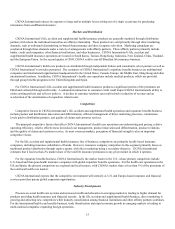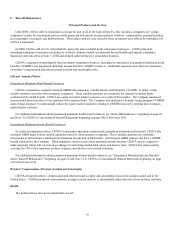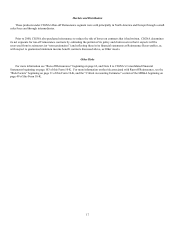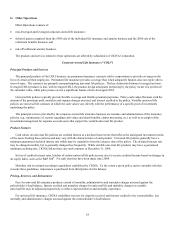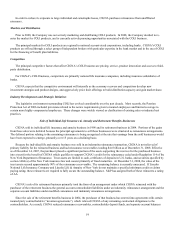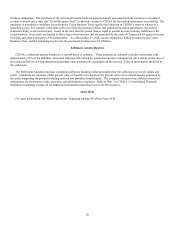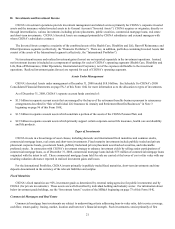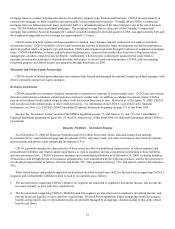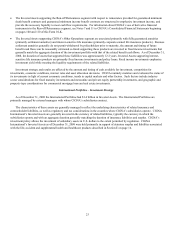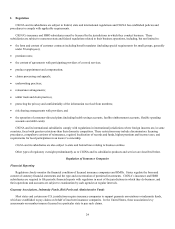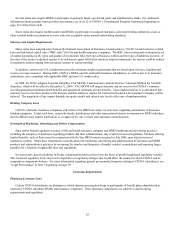Cigna 2008 Annual Report Download - page 35
Download and view the complete annual report
Please find page 35 of the 2008 Cigna annual report below. You can navigate through the pages in the report by either clicking on the pages listed below, or by using the keyword search tool below to find specific information within the annual report.15
CIGNA International reduces its exposure to large and/or multiple losses arising out of a single occurrence by purchasing
reinsurance from unaffiliated reinsurers.
Markets and Distribution
CIGNA International’s life, accident and supplemental health insurance products are generally marketed through distribution
partners with whom the individual insured has an affinity relationship. These products are sold primarily through direct marketing
channels, such as outbound telemarketing, in-branch bancassurance and direct response television. Marketing campaigns are
conducted through these channels under a variety of arrangements with affinity partners. These affinity partners primarily include
banks, credit card companies, other financial institutions, and other businesses. CIGNA International’s life, accident and
supplemental health insurance operations are located in South Korea, Taiwan, Hong Kong, Indonesia, New Zealand, China, Thailand,
and the European Union. In the second quarter of 2008, CIGNA sold its run-off Brazilian life insurance business.
CIGNA International’s health care products are distributed through independent brokers and consultants, select partners as well as
CIGNA International’s own sales personnel. The customers of CIGNA International’s expatriate benefits business are multinational
companies and international organizations headquartered in the United States, Canada, Europe, the Middle East, Hong Kong and other
international locations. In addition, CIGNA International’s health care operations include medical products, which are provided
through group benefits programs in the United Kingdom and Spain.
For CIGNA International’s life, accident and supplemental health insurance products a significant portion of the premiums are
billed and collected through credit cards. A substantial contraction in consumer credit could impact CIGNA International's ability to
retain existing policies and sell new policies. A decline in customer retention can result in both a reduction of revenue and an
acceleration of the amortization of acquisition related costs.
Competition
Competitive factors in CIGNA International’s life, accident and supplemental health operations and expatriate benefits business
include product and distribution innovation and differentiation, efficient management of direct marketing processes, commission
levels paid to distribution partners, and quality of claims and customer services.
The principal competitive factors that affect CIGNA International’s health care operations are underwriting and pricing, relative
operating efficiency, relative effectiveness in medical cost management, product innovation and differentiation, producer relations,
and the quality of claims and customer service. In most overseas markets, perception of financial strength is also an important
competitive factor.
For the life, accident and supplemental health insurance line of business, competitors are primarily locally based insurance
companies, including insurance subsidiaries of banks. However, insurance company competitors in this segment primarily focus on
traditional product distribution through captive agents, with direct marketing being a secondary objective. CIGNA International
estimates that it has less than 2% market share of the total life insurance premiums in any given market in which it operates.
For the expatriate benefits business, CIGNA International is the market leader in the U.S., whose primary competitors include
U.S.-based and European health insurance companies with global expatriate benefits operations. For the health care operations in the
UK and Spain, the primary competitors are regional and local insurers, with CIGNA's market share at less than 5% of the premiums of
the total local health care market.
CIGNA International expects that the competitive environment will intensify as U.S. and Europe-based insurance and financial
services providers pursue global expansion opportunities.
Industry Developments
Pressure on social health care systems and increased wealth and education in emerging markets is leading to higher demand for
products providing health insurance and financial security. In the life, accident and supplemental health business, direct marketing is
growing and attracting new competitors while industry consolidation among financial institutions and other affinity partners continues.
For the international health care benefits business, trade liberalization and rapid economic growth in emerging markets is leading to
multi-national companies expanding foreign operations.












